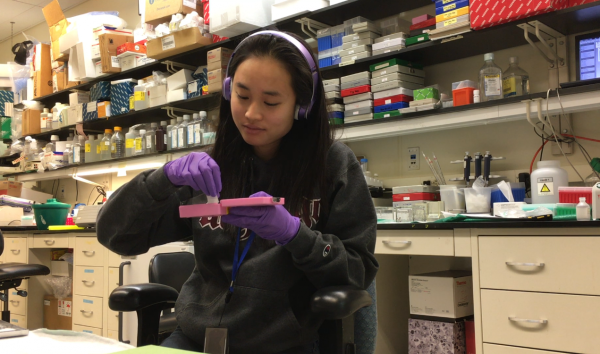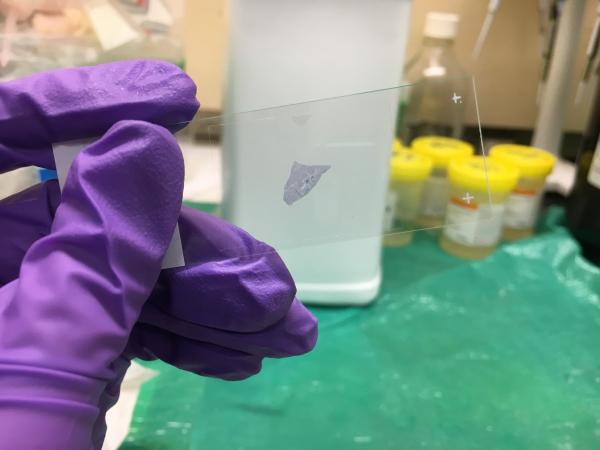Life of a Postbac: My Experience Joining the NIH Family

As an IRP postbac, I am responsible for a wide array of research tasks. Here I am organizing microscope slides containing sections of mouse lung tissue.
It was picture day, and I sat stiffly in front of a wrinkly blue curtain, nervously patting my hair into place. “You can smile, but just make sure no teeth are showing,” the person taking my picture told me. I laughed at that, and she also laughed, adding, “Everyone gets a good chuckle out of that one,” as she snapped my photo. A few days later, I picked up my photo, printed (not so) nicely with a vertical stripe running down my face. I didn’t even notice. I thought, this is real, as I proudly held up my official NIH ID badge.
Just a few months prior, I had graduated from the University of Chicago. In the months leading up to graduation, I had no idea where I was going to work after college. Since I was interested in taking a couple of gap years before pursuing graduate school, I started looking into postbaccalaureate programs. During undergrad, I worked in a neuroscience lab, where I studied how a part of the brain called the cerebellum governs motor coordination in mice. However, I wanted to study not just how something mechanistically worked but also test out the efficacy of drugs, so I moved to an organic chemistry lab next to focus on the chemical aspect of drug discovery. There, I helped optimize Diels-Alder reactions, which reliably form six-membered ring systems as well as control the creation of specific isomers of drug compounds. Moving forward, I wanted to do research that was more translational, where I could test a drug in animal models and see if it improved their disease.

Stained mouse lung tissue allows us to visualize the microscopic structure, or histology, of the cells’ nuclei and cytoplasm.
My biochemistry professor recommended the NIH Intramural Research Training Award (IRTA) program to me as a stepping stone towards graduate school, and I found that there were many kinds of research to explore in the IRP. After applying, I began emailing different Principal Investigators to see if they had openings for the Fall. Thus began my journey towards becoming a Postbaccalaureate IRTA Fellow, or postbac, at the NIH.
I ultimately landed in Dr. George Kunos’s lab at the NIH National Institute on Alcohol Abuse and Alcoholism (NIAAA), because it aligned most with my interests in drug research. As someone afflicted with many illnesses (allergies, eczema, bad knees, you name it) and who has taken many medications, I wanted to develop viable drugs to cure different diseases. In the Kunos lab, I found the opportunity to learn about the types of assays used to test drug efficacy and conduct preclinical mouse research for reporting to pharmaceutical companies interested in bringing our drugs to clinical trials. Contributing to the many projects in our lab also exposes me to many disease models and provides me with a diverse skillset.
I am currently helping test a novel drug the Kunos lab developed, an endocannabinoid antagonist, on different disease models in mice. The compound binds to and inhibits G-protein coupled cannabinoid (CB) receptors, specifically type CB1R, which recognize THC (the psychoactive ingredient in marijuana). Previous research had explored the use of CB1R antagonists in treating obesity, since activating CB1Rs increases appetite, but those pharmaceutical agents caused significant neuropsychiatric side effects, including anxiety and paranoia.

My research mentors, Dr. George Kunos (left) and Dr. Resat Cinar (right), provide invaluable guidance and support.
The drug developed at the Kunos lab, however, does not cross the blood-brain barrier and thus does not cause those side effects. We are testing the efficacy of our drug for different types of diseases, with my projects focused on pulmonary fibrosis and skin fibrosis. Fibrosis is the thickening and scarring of connective tissue arising spontaneously or due to traumatic injury, and the activation of peripheral CB1R pathways has previously been shown to promote fibrosis progression in multiple organs, including the liver, kidney, heart, and skin. We therefore believe that our drug can reverse the fibrosis by inhibiting these pathways.
I work on projects under Dr. Resat Cinar, a staff scientist at the lab, and with two other postbacs, Josh and Nick, who came to the lab before I did. I like to think of Dr. Kunos as my grandfather, who is wise and knowledgeable; Resat as my father, who teaches me lab techniques and the science behind the experiments; and Josh and Nick as my older brothers, who help me out when I have a quick question.
Projects are beginning to pick up, and I am excited to play an integral part in contributing to research that can someday help people. I look forward to going into more detail about my lab life in future posts, and I am happy to be a part of the NIH family!
Related Blog Posts
This page was last updated on Monday, January 29, 2024
